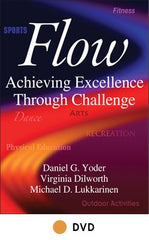Applying Flow to Sport and Coaching
For an athlete to perform at his best, it is important for him to be in a state of flow or, as it is often termed, in the zone. In order for this to occur, he must be well prepared and simply react to what is occurring around him. Preparing an athlete to excel is the main task of any coach. This preparation usually occurs in day-to-day practices where different situations and aspects of the particular sport are drilled over and over again. Practice does not make perfect, but rather perfect practice makes perfect. A coach is always trying to get athletes to be successful by helping them increase their skill levels, keep them in the moment, and free them to simply play the game without attending to internal or external distractions. The coach wants athletes to be absorbed in the game to the point where action and awareness merge and they are very much in the zone. If the coach is able to help athletes get into this state, she has done her job well.
Is there a magic formula that is guaranteed to lead to success? If it were that simple, every coach would be a success. Three coaches at Western Illinois University strive to prepare their athletes for this type of experience every day.
Michael Hunt, head men's and women's tennis coach, realizes there is no guarantee his athletes will get to the level of being in flow, but every day he tries to prepare them for such a state. His structured practices provide opportunities to succeed through constant preparation. Michael strives to prepare them in practice to be ready for what they will face on the court come match day. During a match if things are not going well, he might call a time-out and remind his player of the skills and situations perfected in practice to help the athlete regain confidence and focus.
Holly Van Vlymen, head softball coach, tries to get her players to the point where execution becomes almost second nature. Jennifer Garcia, one of her players, describes being in flow as an almost out-of-body experience where the elements of the game just happen and there is no need to think. Coach Van Vlymen has her players practice many different game situations both offensively and defensively. She talks about maintaining an even keel and not getting too high or too low during a game. She just wants to see her athletes reacting to what the game brings and not having to think, which could lead to hesitation. She will also call her team together during a game to remind them of the skills they have mastered if they appear to be losing focus.
Lia Biehl Lukkarinen, head women's golf coach, strives to keep her athletes in the moment and focused on the process so they are able to execute. Golf is a game of chasing the ball after you have hit it. Sometimes the ball is in an excellent spot, and other times it is not. It is the ability to focus on the shot at hand that matters most, not how the ball got to where it currently rests. Being able to stay in the moment for every shot and block out both internal and external distractions are keys for success in the sport. Coach Lukkarinen works with her players in a practice setting to commit to each shot and then swing away. She will have them pick out a target, envision what the swing needs to be like to get the ball to the target, take practice swings to get the feel of the shot, and then step up to the ball and hit it. This drill helps the players to visualize internally what needs to be done to succeed and how to get their minds ready to focus. This also enables them to block out external distractions such as an opponent noisily putting her clubs in her bag. When Lukkarinen's athletes are able to do this, she believes they are in flow and that their brains and bodies are working as one.




